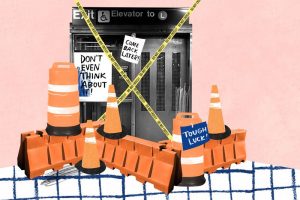David Choi, a lawyer and eight-year resident of New York City, exposes the challenges and physical barriers many wheelchair users face when using public transportation in this article for Curbed New York.
 As the subway train rolled into the Jay Street–MetroTech station in Brooklyn, my stomach churned at the thought of what lay ahead. I wondered to myself why I was so nervous: Having navigated the New York subway system in my power wheelchair for the past five years, this scenario wasn’t anything new.
As the subway train rolled into the Jay Street–MetroTech station in Brooklyn, my stomach churned at the thought of what lay ahead. I wondered to myself why I was so nervous: Having navigated the New York subway system in my power wheelchair for the past five years, this scenario wasn’t anything new.
Around 11:30 p.m., I had just boarded the F train in Manhattan when I received the all-too-familiar email: “There is an outage reported for Elevator el708 located … at jay st – metrotech station.”
I had had an eerie feeling this moment was coming. My recent streak of incident-free travel was bound to come to an end. The timing of this particular outage alert couldn’t have been worse: Had I received the email merely two seconds earlier, I would have quickly gotten off the train and brainstormed other options.
As I guided my wheelchair off the train, I saw an oversized barricade in front of the elevator. It seemed rather symbolic. As if an “Out of Order” sign wasn’t enough, the barrier made the message even clearer: There was no way past it.
I asked my aide, who assists me throughout the day, to run upstairs to find any staff of the Metropolitan Transportation Authority—anybody at all—for help. He reported back that the employee at the ticket booth would try to locate a technician. But no guarantees, he was told.
I weighed my options. There was only one alternative: Riding to the next accessible station, eight stops away. At midnight, it was hardly an attractive option. So, I sat and waited.
After what felt like hours, a technician finally arrived—and just like that, he turned on the elevator and guided it down from the mezzanine floor to the platform. “What happened?” I asked, as I boarded the elevator, working to mask my exasperation as best I could.
He looked at me sheepishly for a brief moment, avoiding eye contact. “Uh… maintenance. Yeah, maintenance.”
“What kind of maintenance?” There was not a technician in sight when I first arrived at the elevator.
This time he refused to answer. Not wanting to antagonize the one person who could let me out of my misery, I let out a little sigh, thanking him politely as I exited the elevator. This was a lucky night: Unlike most other occasions, this elevator wasn’t actually broken.
I still don’t know why the elevator was taken out of service that evening. Reviewing the pattern of elevator outage email alerts—a saving grace provided by the MTA website—it seems the Jay Street elevator is frequently shut down overnight, perhaps to prevent deviants from peeing inside it.
That it is stressful to live under the constant fear that I may not make it home is an understatement. But the impact of the barriers I face while using the transit system goes far deeper. The unreliability of public transportation means moving to the neighborhood in which a new job is located, wrangling with my landlord to negotiate an early termination of my existing lease. It means scheduling dates, brunches, and dinners at restaurants near my home, or in the vicinity of accessible subway stations, which make up less than a quarter of all stations. All while praying the elevator at the nearest station doesn’t go out of service.
Don’t get me wrong: In a time of increased chaos on New York’s subway system, I am grateful for the ways in which mass transit is still available to me. I refuse to complain about the extra time I need to strategize the route to my destination, and the extra time it takes to get there. That’s sort of a calling for people with disabilities: taking obstacles in stride and finding creative ways around them.
“Life is unpredictable—particularly in New York. The location of your client meeting can change on a dime.”
But life is unpredictable—particularly in New York. The location of your client meeting can change on a dime. Your friends can decide on a whim to try out a different restaurant on the other side of the island. Without the ability to jump into a cab—only 4 percent had accessible ramps installed by 2015—I am forced to reschedule or simply forego the opportunity.
I’ve spent much time thinking about how I can push for change. I have written letters to the mayor’s office, only to receive a generic response stating that the government is doing its best. So what’s the solution? Legal action is a valid option. Earlier this year, Disability Rights Advocates filed two class-action lawsuits against the MTA for discrimination. A lawyer by trade, I am all for the use of legal force to bring about change. I am able to live and work because of the Americans with Disabilities Act.
However, the ADA is not without its faults: small businesses have been slapped with lawsuits for very minor noncompliance, such as installing a soap dispenser an eighth of an inch lower than the mandated height. Because of this, some business owners have come to view patrons or employees with disabilities with fear.
Accessibility should not be viewed as an issue of legal compliance or infrastructure. The legal fights and penalties for noncompliance sometimes obscure the underlying human problem: A person in a wheelchair just wants to get home for the night. What can we do to make sure that person can do so safely and without undue delay? You don’t need a judge or rulebook to answer that question reasonably.
What’s needed is empathy and creativity. I am planning a project to partner with small businesses in New York City by providing a simple portable ramp for the storefront. Any establishment with a step in the front could use the ramp whenever a patron in a wheelchair seeks to enter. The project is meant to show that human initiative, not legal action, is what really brings change. It’s a small step, but it’s a start.
And that’s all I ask of the powers that be: Let’s start with one elevator, one station at a time.

Leave a Reply